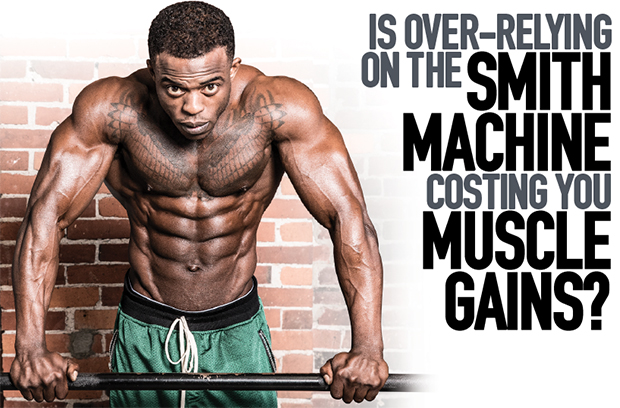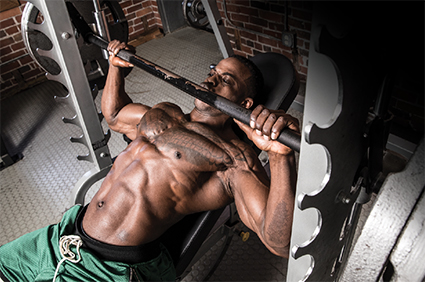Is Over-Relying on the Smith Machine Costing You Muscle Gains?

The versatile Smith machine can aid both beginners and advanced lifters, but each group should be using it for different reasons
The Smith machine is probably the most used piece of machinery in the gym, but some bodybuilders contend it’s overrated. I disagree: It can allow for a heavier load in much safer circumstances, when used correctly, and the Smith machine can be a huge benefit to anyone trying to add muscle. Let’s take a closer look at how the Smith machine can complement your free-weight training so you know how to best use it in your workouts.
Fitness icon Jack LaLanne, who popularized working out on his televised workout program that ran from the 1950s until 1985, is credited with the invention of the machine. So popular was the Smith that it started appearing in gyms nationwide by the end of the ‘50s. Fast forward to today and the Smith machine is still one of the most popular and versatile pieces of equipment you can find in a gym.
One popular misconceptions is that Smith-machine exercises are lumped into the class of free-weight movements. Technically, for an exercise to qualify as free weight, the force of gravity must be able to act freely on the load directly.This isn’t true if you break down the mechanics of the Smith machine: The barbell is locked into place as an attachment in two separate fixed locations, thus allowing for movement only in a fixed plane of motion. You’d need to be able to move the barbell in the Smith machine in any direction you wished (horizontal, as well as vertical) for it to truly be considered “free weight.”

Some manufacturers of Smith machines counterbalance the bar, effectively meaning the non-loaded weight is zero. This lack of initial bar weight can be very useful for beginners who find an Olympic bar (45 pounds) too heavy, the elderly, or trainers who are injured and aren’t able to train through a full range of motion. Beginners often find comfort in the self-spotting security this machine offers. Instead of walking a bar back to a rack with shaky legs after a high-rep set of squats, with one twist of your wrists you can easily self-rack the bar, reducing the risk of potential injury. Many Smith machines also come with blocks or pegs you can set that allow you to limit the range of motion on the lower end, thus better ensuring you won’t get stuck under a bar.
The restricted pathway is one of the machine’s major benefits, but also its drawback. For example, the natural barbell pathway on a squat or bench press isn’t a completely vertical line. Same for the shoulder press, barbell row, or other common movements done on the Smith. Your body is forced to follow that pathway, however, and most often your joints have to adjust accordingly, which can make small compromises to good form. Today some Smith-machine manufactuers actually offer an angled pathway, but that raises the critical question of which way to face when inside the unit, because one is right and the other is wrong.
Like most machines, the Smith machine removes a lot of the need to balance or stabilize the weight, which means it can be ideal for beginners who can learn to practice a motion before actually graduating to the more-difficult free-weight version. But that doesn’t mean advanced lifters can’t make use of the machine. Besides being able to use very heavy weights safely, by reducing the need for stabilizer muscles to contribute, you can better isolate a muscle, which can be more important toward the end of a workout when already highly fatigued. With the need to stabilize and control near-maximal loads absent, you can focus solely on the targeted muscles in a given movement. With the proper programming in place, Smith-machine exercises can be a great add-in for more volume (the total number of sets in your body part workout multiplied by the load), an important marker for hypertrophy. This can be even more important if training technique/form, peri-workout nutrition, and strength are all very good, but a specific body part seems to be lagging or plateauing in terms of hypertrophy.

For more experienced lifters, I’d advise against using the machine early in your workout because free weights offer more functionality in exercises where stabilization is necessary. But toward the latter half of your training session, it’s ideal. With the Smith, you work not only on the movement itself but also proprioception, balance, and sensorimotor coordination. By limiting stabilizers, it’s even possible to go heavier than you might with the Smith’s free-weight counterpart. Greater muscle engagement also contributes to a greater anabolic stimulus. What’s more, you burn more calories as more muscles are being used at any given time.
One last benefit: The Smith is a great place to do exercises that have a very short range of motion. Think calf raises and shrugs, which can be especially useful if your gym doesn’t have any machines for these family of moves. The free-weight movement arc is straight up and down, so that fits perfectly with the machine’s restricted pathway. Such types of exercises are certainly fine to do on the Smith by beginners.
You’ve likely seen gym newbies gravitate to the Smith for squats, bench presses, and other compound movements. After a while, such folks need to be weaned off the machine but may be afraid to do so because free weights seem far more daunting. Don’t be afraid to show these folks a free-weight alternative, which promises to be a better overall muscle builder in the long run. Nobody ever built a championship pair of legs by favoring Smith-machine squats over the free-weight version.
Use both types of equipment for optimal results.

